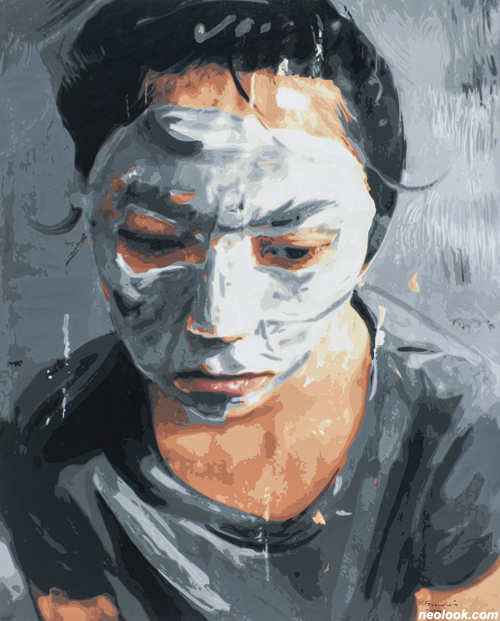- ● homepage
- ● archives
- ● restoration
- ● books
- ● big banners
- ● post board
- ■ neo's search
- ■ about us
- ■ 게재방법 안내
- 개인정보처리방침

- [email protected]
- Tel. 02_335_7922
- Fax. 02_335_7929
- 10:00am~04:30pm
- 월요일~금요일
- 3/3(월) 대체공휴일

궈웨이: 인간에서 인류로 郭伟: 从个体到群像 Guo Wei: A Human towards Humanity
궈웨이展 / Guo Wei / 郭伟 / painting 2016_0701 ▶ 2016_0814 / 월요일 휴관

- 궈웨이_Muscle_캔버스에 아크릴채색_150×120cm_2014
초대일시 / 2016_0701_금요일_05:00pm
관람시간 / 10:00am~06:00pm / 월요일 휴관
학고재 Hakgojae 서울 종로구 삼청로 50(소격동 70번지) Tel. +82.2.720.1524 hakgojae.com
오늘날 '동시대' 라는 범주에서 예술을 논할 때, 중국의 미술은 고유한 특성과 창의성 속에서 새로운 면모를 드러내 왔다고 할 수 있다. 이러한 가운데 특정 한 작가를 집중해 그 역사적 전환과 변화를 읽을 수 있다면 바로 궈웨이(郭伟)와 같은 작가의 작품을 통해서가 아닐까 생각된다.

- 궈웨이_Untitled 12_캔버스에 아크릴채색_150×120cm_2014

- 궈웨이_Untitled 14_캔버스에 아크릴채색_300×220cm_2015
쓰촨미술학원(四川美術學院)을 1989년에 졸업한 궈웨이는 중국 전역에서 일어났던, 1985년의 '85미술운동'을 20대의 저항과 열정의 눈으로 목격한 세대이다. 그는 사회적 현실주의 회화 양식의 자양분을 토대로 자신이 사회주의 국가에서 체험한 격정의 감정을 자신의 신체를 통해 표출하는 방법을 사용한다. 궈웨이는 그의 작품에서 자신의 감정을 거칠고 격렬한 붓 터치가 아닌 즉흥적인 속도감의 붓질로 구사한다. 그리고 그 붓의 속도감 속에서 사회 정치 속의 규범을 허물고, 스스로 질문을 던지는 듯한 제스처를 평온한 조화로 이끈 화면 속에서 보여준다. 그의 작품에서 인물과 인류는 구분된다. 우리 주변에서 볼 수 있는 대중적 미디어 혹은 개인적인 복제를 통한 이미지는 '인물'로 표현된 반면에 그 누구라고 명명할 수 없는 신체는 '인류'로 표현된다고 볼 수 있다.

- 궈웨이_Untitled 7_캔버스에 아크릴채색_150×120cm_2014
궈웨이 회화는 원본의 실재와 가상의 오브제가 만난 공간이며, 철저히 평면성을 고수한 회화의 새로운 경지라고 할 수 있다. 작가에게 있어서 인간은 과거 일상의 형상을 회귀시키는 동시에 자신의 의식을 재확인 시키는 인식 과정이라고 볼 수 있다. 이러한 인간의 형상을 인류로 옮겨 놓으면서, 그는 주체적인 '인간'에서 익명의 '인류'로 향해 새로운 시대에 직면하는 모습을 보여준다. 따라서 궈웨이는 고유한 회화의 특질을 가지고 새로운 조류에 맞서 개척해 나가는 화가라고 평가할 수 있을 것이다. ('인간에서 인류로: 궈웨이(郭伟) 회화의 리얼리티와 가공 세계' 발췌) ■ 문정희

- 궈웨이_Untitled_캔버스에 아크릴채색_120×85cm_2013
In the context of discussions on the "contemporary art" emerging in recent years, Chinese art can be said to have offered something new within its distinctive characteristics and creativity. If it is in fact possible to observe this historic shift and transformation by focusing on any one artist, then perhaps the work of Guo Wei would offer a means of doing so. ● A 1989 graduate of the Sichuan Fine Arts Institute(四川美術學院), Guo is part of the generation that personally witnessed the "1985 art movement" with all the resistance and passion of someone in his twenties. Nourishing himself on the pictorial approach of social realism, Guo applies methods that use his own body to express the turbulent emotions experienced in his socialist homeland. Guo reveals his feelings not through coarse, intense brushwork, but through strokes of speed and spontaneity. With that speed of stroke, he offers a canvas that generates a serene harmony from gestures that demolish social and political norms – while also seeming to question themselves. It is work that distinguishes "human figures" from "humankind": images from around us that appear through mass media or individual reproduction are represented as human figures, while humankind takes the form of bodies that cannot be identified as anyone in particular. ● In the paintings of Guo Wei, "real" and "virtual" may be described as a space where the reality of the original meets the imaginary of the objet, a new realm of painting that adheres thoroughly to the two-dimensional. For the artist, the human being may be viewed as a process of recognition: returned to the everyday forms of the past, while reaffirming the artist's own consciousness. In shifting these human shapes to humankind, he moves from subjective "human" to anonymous "humankind," showing them faced with a new age. In this way, Guo may be seen as an artist possessing his own distinctive pictorial qualities – someone blazing a trail against a new current. ('A Human towards Humanity: Reality and the Processed World in the Paintings of Guo Wei') ■ MOON Junghee
Vol.20160702f | 궈웨이展 / Guo Wei / 郭伟 / painting
